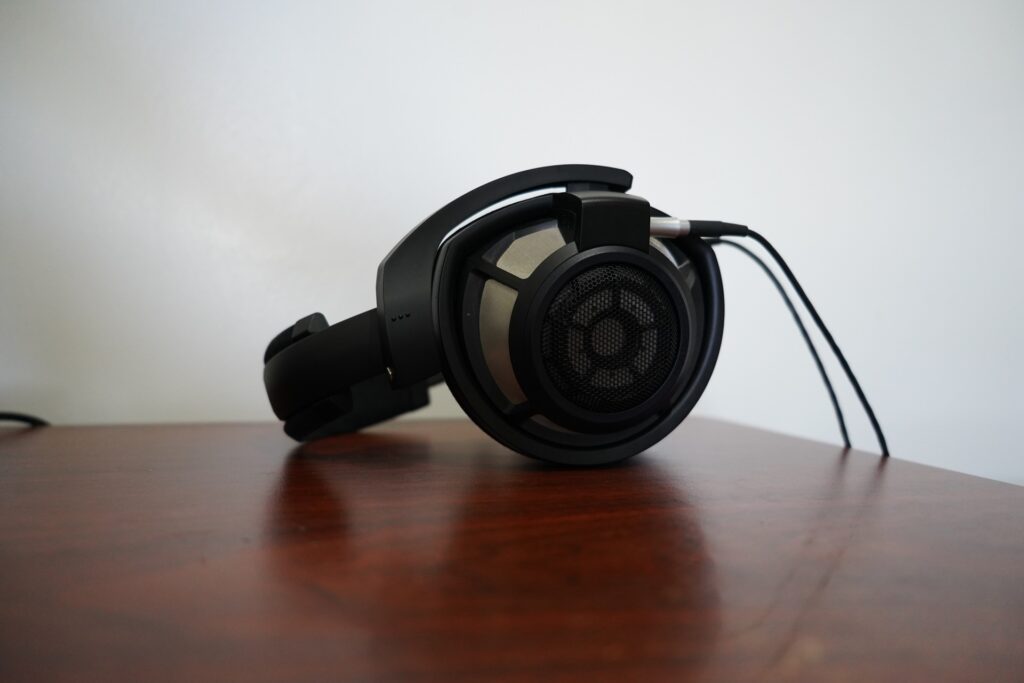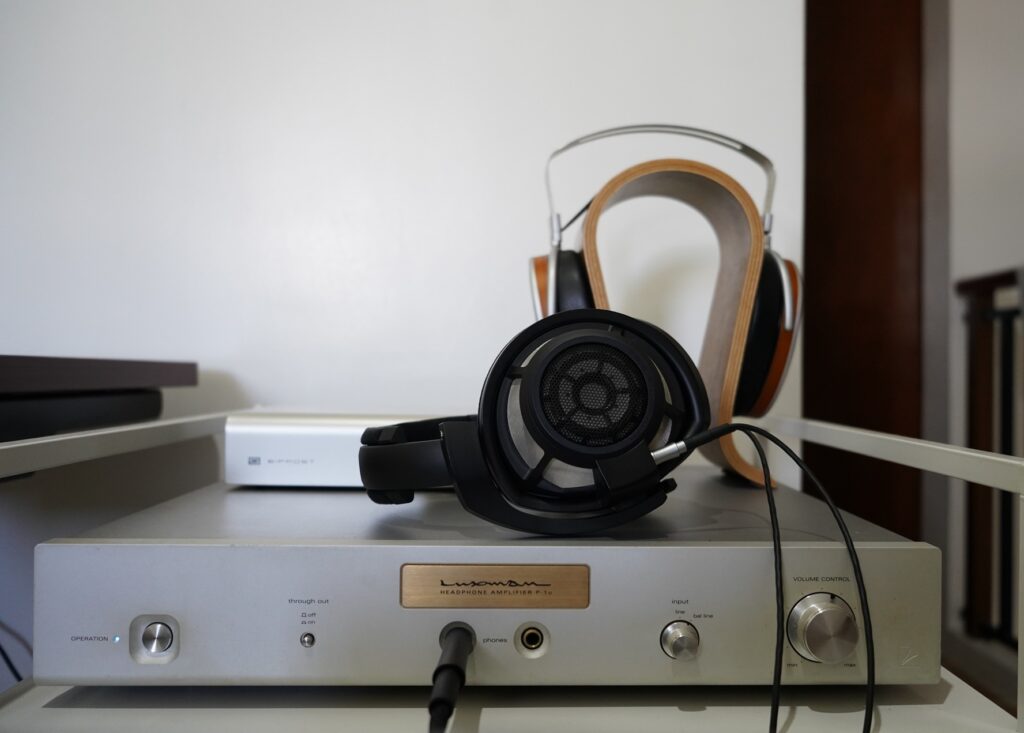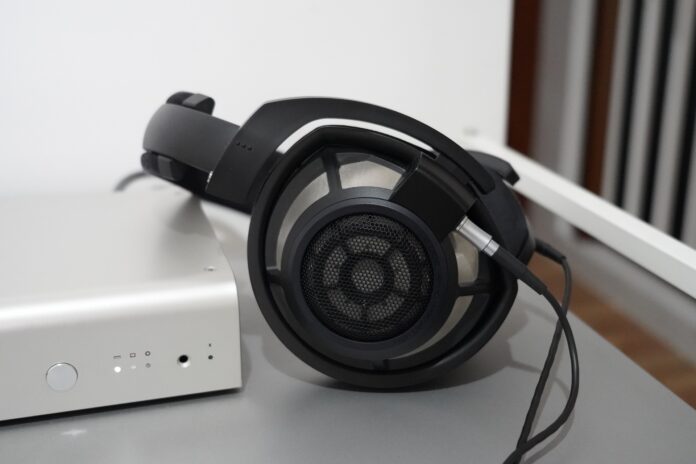Sound
The HD8xx retains the same impressive soundstage and imaging as the HD800s but features a tweaked tuning. For those unfamiliar with its soundstage and imaging, it likely remains one of the best in the industry. The stage is wide, and instrument placement is impeccable, offering a lightness and spaciousness in its music presentation that is quite unique. Some may find it unnatural, but it’s the kind of character that can impress even non-audiophile friends when they give it a listen.
However, the drawback to this presentation is often subpar dynamics and a lack of overall punch. The effortless quality means nothing truly smacks you in the face, which can sometimes detract from the overall enjoyment. Personally, this makes me less likely to tap my feet or move my head compared to more dynamic headphones like the Focal Utopia.
The frequency response or tuning is the biggest point of contention for the HD8xx. Without comparing it to the HD800s, this headphone has a slight broad hump in the upper bass and lower mids, with a steep scoop in the mids and upper mids. This results in slightly boomy bass and richer low mids, while vocals sound muffled and strings lack bite or incisiveness. I characterize this as an “in the tunnel” effect, while others describe it as having a cloth draped over the music. The treble frequencies are somewhat reduced compared to the HD800s, which I think is a good thing.
In comparison to the HD800s, the HD8xx is more musical, meaning it doesn’t sound too thin in the low mids nor too bright up top. While the HD800s might be the better-tuned headphones for audiophiles, those who prefer a warmer sound will likely prefer the HD8xx. The biggest complaint about the HD800s is its clinical and sterile sound when used purely for music listening. It requires wholehearted acceptance of its terms before one can start appreciating it.

The HD8xx attempts to improve the HD800s’ tuning but goes a bit too far, necessitating the use of EQ.
Using EQ
While I don’t religiously follow the Harman or any target curve, I use them as guidelines. I found that bringing up the scooped upper mids a bit and adding a bass shelf gives me a sound I very much enjoy. The slight lift around 1.5-2.5 kHz adds life to that area, and the increased sub-bass shelf reduces the bloomy bass effect. I didn’t bother reducing the warmth around the upper bass and lower mids.
After countless hours experimenting with EQ for this headphone, I followed Oratory’s EQ precisely, but the sound wasn’t pleasant. Reducing the bloomy upper bass made the overall listening experience less warm and enjoyable. The upper mids drop, similar to HiFiMAN or ZMF, is something I like, so I just added a couple of dBs and it was great! With EQ, I was able to achieve my preferred tuning and benefit from all the technicalities the HD8xx offers: soundstage, imaging, detail retrieval, you name it.
What If You Don’t Want to EQ?
I understand the reluctance to use EQ, as there’s value in listening to headphones in their stock sound. However, you also want to get the best possible sound from your headphones. If you’re someone who says, “I don’t want my headphones to sound the same,” they won’t sound the same with EQ. That’s why I don’t strictly follow the Harman curve; I want the unique characteristics of my headphones to stand out. If you can, utilize EQ. Even though I enjoyed this headphone in its stock sound, making small tweaks made it more enjoyable for me.
If you can only have one high-end headphone and don’t want to EQ at all, it becomes much harder to recommend the HD8xx. Perhaps if you like a warm and relaxed sound with exceptional stage and imaging, it could work.
Amplification
The HD8xx is a 300-ohm headphone, so it’s recommended to use an amplifier to get the most out of it. It’s not surprisingly hard to drive, though, as it can reach a good volume out of a standard headphone output, and the sound is not too far off. Subjectively, the tunnel character is more pronounced when un-amped.

I use a Luxman P1u, which sounds okay. The P1u and HD800/HD800s have always had great synergy, so I’m pretty happy with the pairing. However, I also tried the THX 887, which sounded good. Any good clean-sounding amplifier would be sufficient. If you want to splurge, you can also use tubes, as the HD8xx benefits from being a high-impedance headphone. I don’t have any tube amplifiers, so I can’t comment on that with any firsthand experience.
Conclusion
In conclusion, there are several ways to view the HD8xx as a product in the market.
You can see it as the cheapest way to get an HD800s. While the HD800 is still available, it’s an older product, making it harder to find a used version without worrying about its mileage. Plus, the HD800 has an annoying treble peak that’s hard to remove even with EQ, so you’ll have to rely on physical modding.
If the HD800s is out of context, the HD8xx offers the best soundstaging and imaging for its price. While the HiFiMAN egg-shaped cans are also good, the HD800s/HD8xx stage presentation is different. It’s wider, and instrument placement is more precise, whereas the HiFiMANs are more diffused and somewhat taller due to their cup size.
If you’re like me, looking for the HD800s stage and imaging specifically, and don’t mind using EQ, I’d recommend the HD8xx in a heartbeat if you can find one. I got this headphone for roughly $650 in a used market, and I see it priced similarly on the Head-fi marketplace as of this review.
Is there value in getting this over the HD800s if the price difference is minimal or if the price isn’t an issue? It’s hard to say. Here in the Philippines, there aren’t many used HD800s available, and when they are, they’re still quite expensive. So it depends on your location and the product’s availability.
That’s it for the HD8xx by Sennheiser and Drop. I hope this review is helpful if you’re considering getting this headphone and you’re at a crossroads. See you in the next one!


